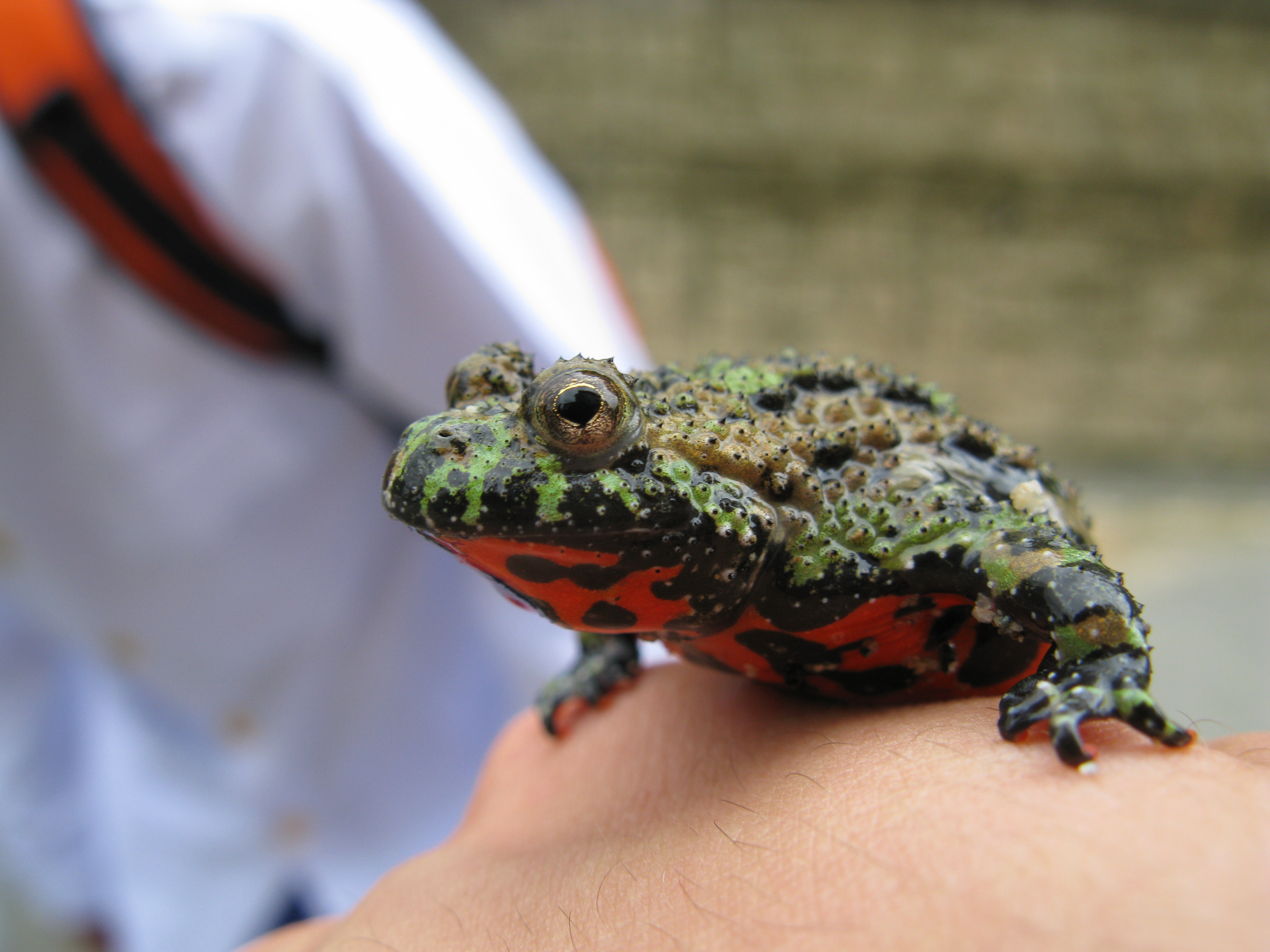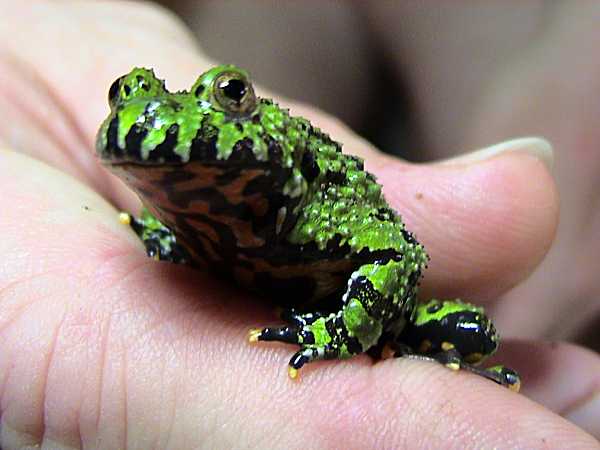The Enchanting World of the Oriental Fire-bellied Toad (Bombina orientalis)#
Deep within the lush, temperate forests and quiet wetlands of Northeast Asia, a small yet vividly colored amphibian thrives beneath layers of leaves and beside tranquil pools of water. The Oriental Fire-bellied Toad, scientifically named Bombina orientalis, captivates observers with its striking appearance and intriguing behaviors. Known for its brilliant underbelly marked with fiery reds, oranges, and blacks, this amphibian signals both beauty and toxicity in its vibrant warning to would-be predators.
But beyond its remarkable coloration and diminutive stature lies a unique amphibian deeply intertwined with the harmony of its ecosystem—a species whose very existence serves as an indicator of environmental health and stability. Let us journey into the vivid, often secretive world of the Oriental Fire-bellied Toad, exploring the depth of its characteristics, behavior, ecological significance, and the efforts to preserve its delicate existence.
Taxonomy and Classification#
The Oriental Fire-bellied Toad, Bombina orientalis, belongs to the family Bombinatoridae. Unlike true toads (family Bufonidae), fire-bellies represent a different lineage, distinctively classified due to their peculiar anatomy and behavior. Within the genus Bombina, which comprises numerous species of fire-bellied toads distributed across Eurasia, B. orientalis stands out as the most widely recognized member, thanks partially to its vibrant coloration and popularity among amphibian enthusiasts.
First described scientifically by the renowned zoologist and naturalist George Albert Boulenger in 1890, B. orientalis is closely related to other species within its genus, including the European Fire-bellied Toad (Bombina bombina) and the Yellow-bellied Toad (B. variegata). However, it is distinguished by its specific geographic range and unique physical features.
Natural Habitat#
The natural home of the Oriental Fire-bellied Toad stretches across northeastern Asia, including China (particularly Manchuria), Korea, parts of Siberian Russia, and even extending slightly into eastern Mongolia. This amphibian is primarily associated with temperate forests, marshlands, swamps, slow-moving streams, and shallow ponds fringed with aquatic vegetation. These habitats provide the moisture and environmental conditions necessary for its survival, reproduction, and development.
Life Amid Harmony: Environmental Preferences#
The Oriental Fire-bellied Toad is semi-aquatic, frequently found near or partially submerged in calm freshwater bodies rich in aquatic plant life and gentle slopes toward the bank rather than sharp-edged shores. Its existence depends heavily upon pristine water quality and stable terrestrial surroundings, abundant leaf litter, rocks, and logs for shelter and moisture retention.
Seasonality plays a crucial role; these toads experience significant changes in weather. During colder months, they retreat to terrestrial burrowing sites to hibernate, sheltering themselves within soft soils beneath humus layers or undisturbed leaf piles. In warmer periods, a chorus of melodic calls echo softly across ponds and wetlands, signaling reproduction and territory establishment.
Physical Characteristics#
From a distance, the Oriental Fire-bellied Toad’s diminutive size—measuring only 4 to 7 centimeters (1.5 to 2.7 inches)—might belie its vibrant allure. Upon closer inspection, the amphibian reveals stunning contrasting textures and colors. Its dorsal surface, rough and bumpy in texture, ranges from olive to mossy green, allowing the toad an effective camouflage among leaf litter and vegetation. Discreet black speckles pepper the surface irregularly, aiding further concealment from aerial predators or curious terrestrial predators.
However, as individuals approach a curious observer or respond defensively to potential threats, their hidden secret becomes startlingly apparent. Turning themselves over in a defensive tactic known as the “unkenreflex,” the fire-bellied toad flips backward, arching its legs to unveil a vivid ventral display of fiery oranges, reds, and stark blacks—a clear, unmistakable warning to predators.
Adaptive Significance of Coloration#
This vivid underbelly is far from merely decorative. Known as aposematic coloration in scientific terms, it provides effective communication, warning predators of toxic substances hidden beneath their appealing form. The skin secretes substances mildly toxic to most predators, causing irritation or gastrointestinal discomfort when ingested. Over evolutionary timeframes, this striking coloration has become an integral survival strategy, a visible deterrent evolving in tandem with an unseen yet powerful chemical defense.
Behavior and Life Cycle#
The Oriental Fire-bellied Toad exhibits behaviors as fascinatingly rich as its physical traits. Generally crepuscular and nocturnal by nature, it emerges at twilight, particularly noticeable after rainfall when the world is damp, cool, and filled with life. Using its sharp eyesight and sensitive detection of vibrations, the toad scours its territory in search of prey. Its diet primarily includes insects, small invertebrates, worms, and occasionally smaller amphibians or aquatic larvae. Although not particularly agile hunters, their patient stalking and sudden lunges prove highly effective within their chosen habitats.
Breeding Rituals Amid Shallow Waters#
During the breeding season, male Oriental Fire-bellied Toads serenade females with distinctive vocal calls, gentle “oop-oop-oop” resonances slicing through quiet evenings. Congregating in slow-moving waters, shallow ponds, marshes, or temporary vernal pools, males establish territories and await receptive females. Upon pairing, the female deposits clusters of eggs upon submerged plants, leaves, and twigs. With spawning complete, parental investment is minimal, and the adults depart, leaving their developing offspring in nature’s care.
The small tadpoles hatch approximately one week thereafter, quickly adapting to aquatic habitats. Over six to ten weeks, they undergo complete metamorphosis, transitioning gracefully from aquatic larvae with external gills to small, fully terrestrial juveniles capable of surviving both land and water conditions. This dual life-phase cycle highlights their remarkable adaptation to varied environments, essential for their ongoing survival.
Ecological Role#
The Oriental Fire-bellied Toad fulfills an integral role within its ecosystem, functioning as both predator and prey to form ecological balance. As active insectivores, these toads serve as effective regulators of local insect populations, ensuring pests do not overwhelm plant communities. They indirectly support pollinators and vegetation indirectly by predation on insects detrimental to foliage.
Conversely, as a frequent prey item for birds, fish, snakes, and mammals capable of tolerating or circumventing its toxicity, B. orientalis contributes substantially to local food web stability. Their presence and population dynamics are even utilized as reliable bioindicator research subjects to gauge ecological health—specifically the purity of aquatic ecosystems, habitat integrity, and environmental stability.
Threats and Conservation Status#
Despite its relatively stable population and widespread distribution, the Oriental Fire-bellied Toad’s future hinges precariously upon persistent environmental threats. While classified by the IUCN Red List as a species of “Least Concern,” current habitat destruction due to urbanization, agriculture, pollution, and human infrastructure places local populations at risk, especially across fragmented habitats.
Additionally, unsustainable collection for the pet trade industry presents challenges, particularly in certain regions where wild populations are targeted rather than captive-bred animals. Climate change exacerbates population pressures, altering local hydrological cycles and disrupting optimal seasonal reproductive timing, impacting breeding success and survivability.
Cultural and Scientific Significance#
Beyond its ecological and aesthetic charm, the Oriental Fire-bellied Toad holds cultural significance in parts of East Asia. Symbolic in folklore and traditional narratives, fire-bellied toads embody resilience and harmony, frequently appearing as celebrated animals in artwork and storytelling.
Scientifically, their skin secretions have elicited substantial research interest. Scientists study these secretions for potential antimicrobial, antifungal properties, or unique chemical compounds valuable for medical purposes. Amphibians like B. orientalis thus underscore the vast but delicate genetic and biochemical repository residing within wild species, emphasizing the necessity of their conservation and protection.
Conclusion#
The story of the Oriental Fire-bellied Toad is an enduring testament to ecological balance, adaptive evolution, and biological intricacy hidden beneath humble stature. As we marvel at this amphibian’s vibrant display, harmonious behaviors, and captivating presence, we must equally recognize our role in safeguarding its delicate existence for generations to appreciate continually.
Let this narrative inspire your curiosity and motivate you to advocate for the preservation of vital habitats and biodiversity. By supporting environmental conservation efforts, responsibly choosing companion animals from ethical sources, and fostering education, each one of us can contribute meaningfully to the continued enchantment of species such as Bombina orientalis.















